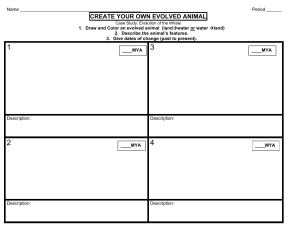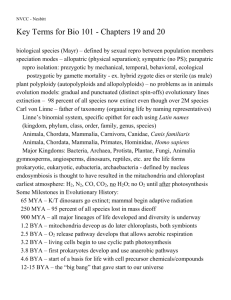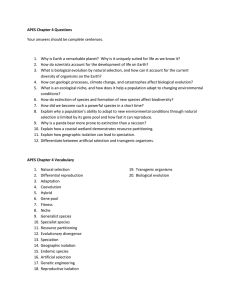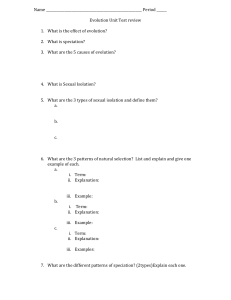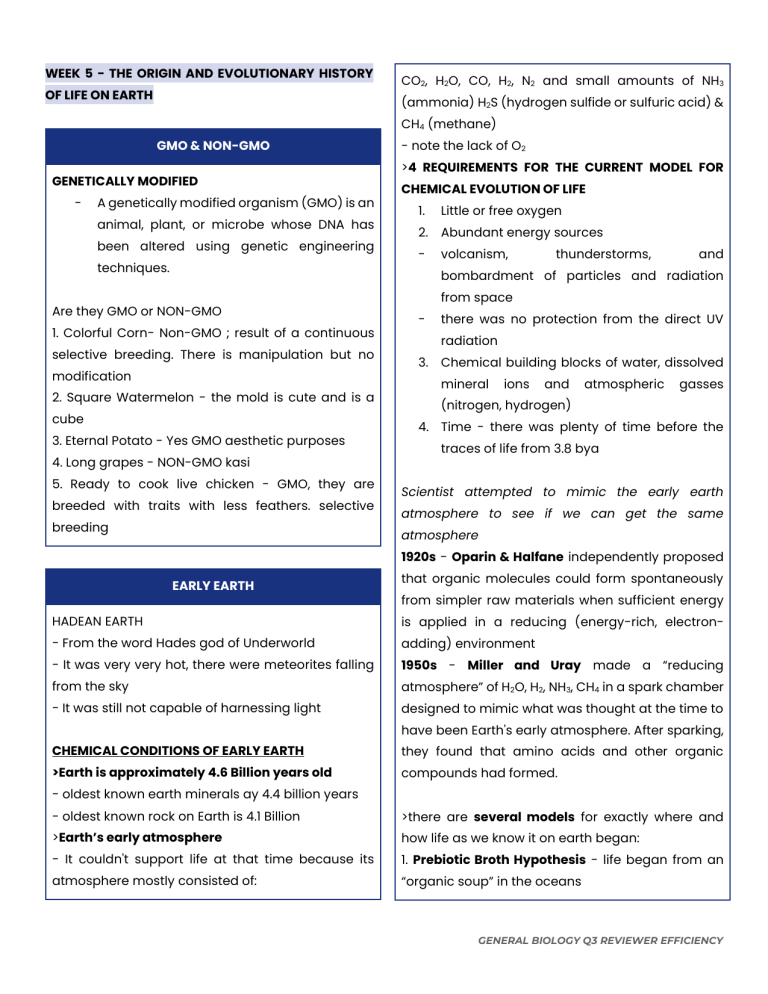
WEEK 5 - THE ORIGIN AND EVOLUTIONARY HISTORY OF LIFE ON EARTH CO2, H2O, CO, H2, N2 and small amounts of NH3 (ammonia) H2S (hydrogen sulfide or sulfuric acid) & CH4 (methane) GMO & NON-GMO GENETICALLY MODIFIED - A genetically modified organism (GMO) is an animal, plant, or microbe whose DNA has been altered using genetic engineering techniques. - note the lack of O2 >4 REQUIREMENTS FOR THE CURRENT MODEL FOR CHEMICAL EVOLUTION OF LIFE 1. Little or free oxygen 2. Abundant energy sources - volcanism, thunderstorms, and bombardment of particles and radiation Are they GMO or NON-GMO 1. Colorful Corn- Non-GMO ; result of a continuous selective breeding. There is manipulation but no modification 2. Square Watermelon - the mold is cute and is a cube 3. Eternal Potato - Yes GMO aesthetic purposes 4. Long grapes - NON-GMO kasi 5. Ready to cook live chicken - GMO, they are breeded with traits with less feathers. selective breeding from space - there was no protection from the direct UV radiation 3. Chemical building blocks of water, dissolved mineral ions and atmospheric gasses (nitrogen, hydrogen) 4. Time - there was plenty of time before the traces of life from 3.8 bya Scientist attempted to mimic the early earth atmosphere to see if we can get the same atmosphere 1920s - Oparin & Halfane independently proposed EARLY EARTH that organic molecules could form spontaneously from simpler raw materials when sufficient energy HADEAN EARTH is applied in a reducing (energy-rich, electron- - From the word Hades god of Underworld adding) environment - It was very very hot, there were meteorites falling 1950s - Miller and Uray made a “reducing from the sky atmosphere” of H2O, H2, NH3, CH4 in a spark chamber - It was still not capable of harnessing light designed to mimic what was thought at the time to have been Earth's early atmosphere. After sparking, CHEMICAL CONDITIONS OF EARLY EARTH they found that amino acids and other organic >Earth is approximately 4.6 Billion years old compounds had formed. - oldest known earth minerals ay 4.4 billion years - oldest known rock on Earth is 4.1 Billion >there are several models for exactly where and >Earth’s early atmosphere how life as we know it on earth began: - It couldn't support life at that time because its 1. Prebiotic Broth Hypothesis - life began from an atmosphere mostly consisted of: “organic soup” in the oceans GENERAL BIOLOGY Q3 REVIEWER EFFICIENCY 2. Bubble Hypothesis - a variation on the prebiotic - broth, with “oily bubbles” from an organic soup interacting with land surfaces at shallow seas or Petrified wood has been replaced by mineralization. - Even though its original woody texture is seashores preserved, it consists entirely of minerals like 3. Iron-Sulfur World Hypothesis - life began from crystalline quartz, chalcedony, or agate. an "organic soup" interacting with mineral surfaces - Trace fossils are indirect evidence of at hydrothermal vents in the ocean floor, with organisms: tracks and traits , wormholes and abundant iron and sulfur there impacting the early burrows, nests, feces (corpites) , calcite metabolism that developed mounds (stromatolites) 4. Deep-Hot Biosphere Hypothesis - life began in - an "organic soup" deep within the Earth 5. Exogenesis - Earth was seeded with life from an extraterrestrial source Some organisms are frozen in permafrost, like this wooly mammoth - Some organisms are trapped and preserved whole in amber or tar like this eocene to oligocene age mosquito. A MODEL FOR THE FIRST CELLS > STROMATOLITES are rocklike structures made up > PROTOBIONTS have been produced that resemble of layers of bacteria and sediment they are found in living cells water areas until today - microspheres - a type of protobiont, form - the first evidence of life in the fossil record are spontaneously when liquid water is added to isotopic carbon "fingerprints" in rocks from ~3.8 bya abiotically produced polypeptides; they can grow, - the first evidence of cells are microfossils of divide, and maintain internal chemistry different prokaryotic cells in fossils of stromatolites dated to from their surroundings ~3.5 bya - genetic reproduction was crucial in the origin of > THE FIRST CELLS WERE MOST LIKELY ANAEROBIC true life HETEROTROPHS > RNA likely was first (RNA world hypothesis) ↳ Anaerobic meaning does not give oxygen. Because of the lack ↳ RNA can catalyze a variety of reactions, including some self- of oxygen back then ↳ There was likely an abundance of organic molecules available catalytic reactions ↳ RNA can also store genetic information ↳ in vitro evolution of RNA has shown that the RNA world hypothesis is feasible - selection can act on self- for food early on the first photosynthetic organisms were likely the purple and green sulfur bacteria, which use H2S as a hydrogen donor replicating RNA molecules in vitro - DNA likely came later and had the selective LIFE CHANGES THE PLANET: OXYGENATING EARTH’S advantage of greater stability OCEANS AND ATMOSPHERE >Cyanobacteria changed the game in a sense by FIRST LIFE, HOWEVER IT CAME TO BE conducting photosynthesis that it did not use How Fossils Form sulfuric acid as a donor, but instead using hydrogen - MINERALIZATION - bones and other hard ↳ stromatolites from as old as 3.5 bya containing what appear parts are replaced by minerals carried in soil to be fossil cyanobacteria groundwater. GENERAL BIOLOGY Q3 REVIEWER EFFICIENCY ↳ many stromatolites with what appear to by fossil - many of the transitions between the divisions are cyanobacteria date to about 2.5 bya marked by major extinction events ↳ banded iron formations from about 2.5 bya - there are many major extinction events in the indicate the massive release of O2 into the oceans fossil record; "big five" mass extinction events > by 2 bya, O2 levels began to build up in the atmosphere -the presence of O2 had a profound impact on life on Earth - O2 is toxic to organisms that don't have protective mechanisms; many died as O, levels built up > the formation of the ozone layer (O3) soon after oxygenation of the atmosphere provided protection from UV radiation and allowed life to expand to regions at and near the Earth's surface EUKARYOTIC CELLS DESCENDED FROM PROKARYOTIC CELLS - eukaryotes first appear in the fossil record about 2 bya, long after prokaryotic cells - DNA sequencing provides evidence of common ancestry of all life on Earth, with eukaryotes splitting from Archaea about 2 bya - recall the endosymbiotic theory - model for how at least some of the eukaryotic cell *ERA Precambrian Time - eukaryotic cell organelles, such as mitochondria and plastids, evolved from 542 mya. - we have already covered some of the major events of that time period (origin of life, free-living prokaryotes. from 4.6 bya up to 52 Million years ago (mya); the fossil record is very spotty prior to organelles came to exist ↳ The endosymbiotic theory posits that some *PERIOD oxygenation of the oceans and atmosphere) - Snowball Earth (800 mya - 635 mya) - ended with the Ediacaran Period (635-542 mya), which is widely recognized as having the oldest animal fossils. HISTORY OF LIFE ON EARTH - divisions of geological time are based on major changes in types of organisms found in the fossil record Fossil Records Late Proterozoic - Plants: Land plants probably evolved from green algae about 600 m.y. ago. Life on land may have looked like this GENERAL BIOLOGY Q3 REVIEWER EFFICIENCY - In the seas, bacteria and green algae were along with many other groups of marine common at the end of the Precambrian. organisms Ex: GREEN ALGAE > Silurian Period (438-408 mya) - PHANEROZOIC EON This was the "Golden Age" of cephalopods and brachiopods (a clam-like shellfish). -the eon of visible life, is divided into three major - The first land plants developed, and the first spans of time largely on the basis of characteristic arthropods assemblages of life-forms: the Paleozoic (541 ventured onto land million to 252 million years ago), Mesozoic (252 - million to 66 million years ago), and Cenozoic (66 million years ago to the present) > Cambrian Period (542-488 mya) beginning of period of great diversification - Higher atmospheric oxygen affected skeletal supported larger land - developed. all contemporary animal phyla are ended in a mass extinction event (2nd of the big five) > Carboniferous Period (359-299 mya) many extinct groups - Mississipian and Pennsylvanian this is the biggest expansion in diversity - Reptiles first appear found in the fossil record - amphibians diversify and are the dominant Ozone developed to a level where it blocked terrestrial carnivores (Age of Amphibians) - Burgess shale - most famous example, now found at high mountains - trilobites, brachiopods, molluscs first coral reefs, first terrestrial plants - ended in a mass extinction event (1st of the - big five) likely due to an ice age, perhaps in a gamma to move around on land. > Permian Period (299-251 mya) - with Ichthyostega had features like a tail that it inherited from fish; and legs that allowed it abundant numbers and diversification of: conjunction most of today's major coal deposits are the remains of organisms that lived in this period > Ordovician Period (488-444 mya) - First seed plants - the naked-seed plants - Cambrian explosion - fossils of multicellular ultraviolet radiation. - vascular plants diversify and dominant the developed. Gymnosperms like Glossopteris represented in Cambrian fossils, as well as - - organisms. organisms are abundant in this period - jawed fishes diversify and dominate the seas (Age of Fishes) - - jawed fishes, amphibians, and insects first appear - - First vascular plants; first true terrestrial > Devonian Period (416-359 mya) PALEOZOIC ERA (542-251 mya) and invertebrates) animals - biochemistry (scorpion-like ray by the end of this period, the continents have merged as the Pangaea supercontinent - Permian period (and Paleozoic era) ended burst (251 mya) with a mass extinction event (3rd decimated the trilobites and brachiopods, of the big five); the largest mass extinction GENERAL BIOLOGY Q3 REVIEWER EFFICIENCY on record (as much as 95% or more of all the era ended (65 mya) with a mass extinction species) event (5th of the big five). - evidence points to the impact of a large MESOZOIC ERA (251-65 mya) extraterrestrial body as a likely cause of the - diversification and dominance by reptiles - the extinction event whole era is often called the Age of Reptiles - K-T Boundary -dinosaurs essentially all died out (sometime called the Age of Dinosaurs, but many (unless you count birds as dinosaurs, which some non-dinosaur reptiles were also prominent) scientists do) most gymnosperms also died out, as did many marine organisms. Triassic Period (251-200 mya) - a major impact almost certainly occurred at this - dinosaurs and mammals first appear time; iridium layers worldwide and deposits from - gymnosperms are the dominant land plants tsunamis around the Gulf of Mexico coast of the - Coelophysis, one of the earliest known time provide clear evidence of this dinosaurs - a large crater site in the Yucatán Peninsula of ended with a mass extinction event that Mexico is likely the result of this impact - paved the way for the dinosaurs to rise to prominence (4th of the big five) Jurassic Period (200-146 mya) - CENOZOIC ERA (65 MYA - PRESENT) dinosaurs dominate the land (and other - usually called the Age of Mammals, but: large reptiles dominate the seas and the birds, insects and flowering plants have also skies) undergone massive diversification and have - birds evolve from a dinosaur lineage all achieved some measure of "dominance" - Ex: STEGOSAURUS & ARCHAEOPTERYX in the biosphere during this era - 175-65 m.y.a. A nesting mother, a birdlike 1. Paleogene (65-23 mya) dinosaur called Oviraptor, was found curled 2. Neogene (23 mya - present) - protectively around a nest containing at - many ice ages least 20 eggs - the rise of humans evidence that dinosaurs cared for their - mass extinctions young. - most of these mass extinctions may have Cretaceous Period (146-65 mya) - been caused by the ice age climate, flowering plants evolved around the early humans, or both the current mass extinction Cretaceous and diversified quickly. event (we are in one now, the sixth - many animals (especially insects) extinction) is mostly caused by humans. - appear to have coevolved with flowering 3. an older division into Tertiary(65~2 mya) plants (different species affecting each and Quaternary (~2 mya - present) is still other's evolution) often referred to WEEK 6 - MECHANISMS OF EVOLUTION GENERAL BIOLOGY Q3 REVIEWER EFFICIENCY EVOLUTION on to the next generation because it - descent with modification from a common hereditary. ancestor. >GERMLINE MUTATION - evolution only occurs when there is a change in No change in phenotype mutation occurs in a stretch gene frequency within a population over time of DNA with no function or perhaps the mutation - What does appearance have to do with survival in occurs in a protein-coding region but ends up not nature? Adapt affecting the amino acid sequence of the protein. - Beetles on food restriction - NOT EVOLUTION *Phenotype - physical trait you can observe in the - Beetles with different color - EVOLUTION organism MECHANISMS OF EVOLUTION: is not - mutations that occur in the sperm and egg - Germline mutations occur in a parent’s Mutation, Gene Flow/ Migration, Genetic Drift, Natural reproductive cells (egg or sperm). These Selection mutations change the genetic material that the child receives from WEEK 7 - GENETIC VARIATION, MUTATION, GENE (hereditary). FLOW/ mutations from either parent. MIGRATION, GENETIC DRIFT, NATURAL SELECTION You can their inherit parent germline ex: Cats ear become shaped round >CAUSES OF MUTATION GENETIC VARIATION 1. DNA Fails to copy accurately - Describe the variation in the DNA sequence in each 2. A change in gene / loss of one or more genes of our genomes 3. Rearrangement of genes - Ex: brown eyes can be presented as dominant GENETIC DRIFT MUTATION - - change in genetic sequence - change in the genetic level allele frequencies of a population change over generations due to chance. - *Bottleneck Effect - sharp reduction in the - mutations are random/natural. They can be size of a population due to environmental beneficial, neutral, or harmful to the organism. events (such as famines, earthquakes, floods, - Not all mutations matter to evolution, unless it is a fires, GERMLINE mutation. activities (such as genocide) disease, or droughts) or human - Germline mutation happens in gametes/sex cells - Somatic cells give rise to all non-germline tissues. Mutations in somatic cells are called somatic NATURAL SELECTION - organisms better adapted to their mutations. Because they do not occur in cells that environment tend to survive and produce give rise to gametes, the mutation is not passed more offspring. along to the next generation by sexual means. ↳ Example of Somatic cell mutation is heterochromia. Traits 3 Important Features of Natural Selection 1. that happen in somatic cells but CANNOT be passed Natural Variation in traits (ex, moth colors, b & g beetles) 2. There should be differential reproduction. GENERAL BIOLOGY Q3 REVIEWER EFFICIENCY 3. There is heredity. Evolution cannot happen if thus the next generation will be more likely to you cannot pass it down to the next also have these adaptations. generation. What Makes a Species, a Species? >ARTIFICIAL SELECTION - - There is intervention from humans. - is an evolutionary process in which humans If they are able to reproduce and pass down their genes. consciously select for or against particular WEEK 8 - TYPES OF SPECIATION, EVOLUTION & features in organisms ISOLATION >FITNESS SPECIATION - reproductive success - Having the traits and capabilities to survive in the environment isn't enough to Traits only unique to them. Ex: The concept of the different MR POTATO HEADS A genotype's fitness is the ability to survive, slide of Ms Ayra. They are all mr potato head. All have find a mate, produce offspring and ultimately the same body, hands, legs and hat but they have leave its genes in the next generation. different features ( others don't have eyes, don't have made of natural selection where individuals compete for access to mates and fertilization - - have the ability to find a mate and reproduce >SEXUAL SELECTION - Formation of new and distinct species in the course of evolution. be considered survival of the fittest. You need to - - a mouth, don't have a nose) > TYPES OF SPECIATION 1. Allopatric Speciation (Geographical Barrier) opportunities. - The original population is divided because Dimorphism (physical) of a geographical barrier. Here the evolution of reproductive isolation begins, which leads If you keep on having the advantageous traits, it will to the birth of a new distinct species. have reached adaptation. Evolution caused by ↳ Peripatric Speciation natural selection is adaptation. - This happens when one of the isolated populations has few individuals. **Relationship of Mutation & Natural Selection - 2. Sympatric Speciation sometimes mutations can change the traits - There is no isolation. So species are formed in a way that is advantageous, creating new through polymorphism. Polymorphism is adaptations. Adaptations are physical traits highlighting the different traits on genetic that help an organism survive and reproduce sequence and by having similar variations, in the environment. Natural selection is the proceeding to a new set of species. survival of the fittest and the organisms with - is the evolution of a new species from a the best adaptations will be most fit and best surviving survive in their environment. They will pass continue to inhabit the same geographic down their genes for these adaptations and region. ancestral species while both 3. Parapatric Speciation GENERAL BIOLOGY Q3 REVIEWER EFFICIENCY - Caused by populations adapting to different - Ex: Different frog species live in the same pond but ecological habitats that vary across their breed at different limes ranges or accumulating different mutations 4. Behavioral Isolation by selection or drift in different portions of - Occurs when two species respond to different their ranges. specific courtship patterns - Ex: Some crickets are morphology identical but only TYPES OF EVOLUTION: respond to species-specific mating songs A. DIVERGENT - new species evolves from a common 5. Mechanical Isolation ancestor - B. CONVERGENT - unrelated species becomes copulation (animals) or when flowers are pollinated similar as they adapt to similar environments by different animals (plants) C. PARALLEL - development of a similar trait in - Ex: Bush babies have distinctly shaped genitalia related, but distinct, species, descending from a that will only fit other members from the same common ancestor species Occurs when gentlal differences prevent 6. Gametic Isolation PRE-ZYGOTIC ISOLATING MECHANISMS - happens when the egg and sperm are released but -reproductive isolation that prevents formation of a a zygote is not formed zygote - sperm of one species may not be able to fertilize eggs of another species POST-ZYGOTIC ISOLATING MECHANISM - reproductive isolation that occurs after two species have mated - prevents formation of a fertile offspring 1. Hybrid Inviability - Hybrids are produced but fail to develop to reproductive maturity - Ex: Frogs of the genus Rana can form hybrid 1. Geographical Isolation tadpoles which die before adulthood - the separation of species by physical barriers like 2. Hybrid Infertility water forms, oceans, mountains, etc. - Hybrids fail to produce functional gametes 2. Ecological Isolation - Ex: Mules are the sterile hybrids of a male donkey - Occurs when two species inhabit similar regions, and a female horse but occupy different habitats 3. Hybrid Breakdown - Ex: Lions and tigers occupy different habitats and - The F1 hybrids are fertile but the F2 generation fail do not interbreed (usually) to develop or are infertile 3. Temporal Isolation - Ex: The offspring of hybrid copepods have a - Occurs when two species mate or flower at reduced potential for survival or reproduction different times of the year GENERAL BIOLOGY Q3 REVIEWER EFFICIENCY
